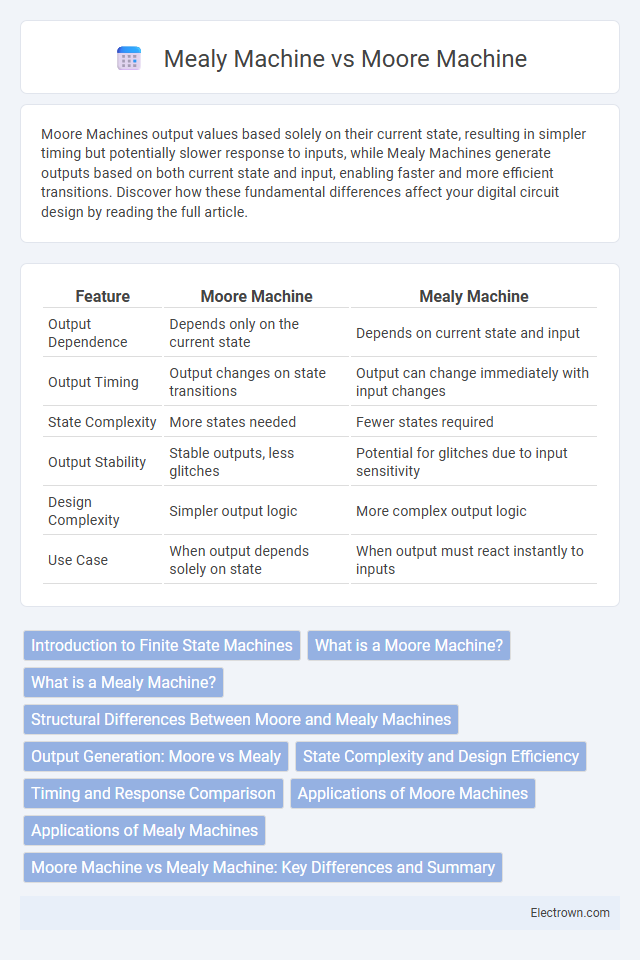Moore Machines output values based solely on their current state, resulting in simpler timing but potentially slower response to inputs, while Mealy Machines generate outputs based on both current state and input, enabling faster and more efficient transitions. Discover how these fundamental differences affect your digital circuit design by reading the full article.
Table of Comparison
| Feature | Moore Machine | Mealy Machine |
|---|---|---|
| Output Dependence | Depends only on the current state | Depends on current state and input |
| Output Timing | Output changes on state transitions | Output can change immediately with input changes |
| State Complexity | More states needed | Fewer states required |
| Output Stability | Stable outputs, less glitches | Potential for glitches due to input sensitivity |
| Design Complexity | Simpler output logic | More complex output logic |
| Use Case | When output depends solely on state | When output must react instantly to inputs |
Introduction to Finite State Machines
Finite State Machines (FSMs) are fundamental computational models used to design sequential logic and control systems, categorized mainly into Moore Machines and Mealy Machines. A Moore Machine outputs depend solely on its current state, making it simpler and more stable by producing outputs at state transitions. In contrast, a Mealy Machine's output depends on both the current state and the input, enabling faster response times but increasing design complexity, which is crucial for optimizing Your digital system's behavior.
What is a Moore Machine?
A Moore Machine is a finite-state automaton where the output solely depends on the current state, making its output stable and predictable. Each state in the Moore Machine produces a fixed output regardless of the input, enhancing the simplicity of design and analysis in sequential circuits. Understanding the Moore Machine helps you implement systems where output stability is crucial, like in digital control applications.
What is a Mealy Machine?
A Mealy machine is a finite-state machine where the output depends on both the current state and the current input, enabling faster reaction to input changes. It is defined by a set of states, inputs, outputs, a state transition function, and an output function mapping state-input pairs to outputs. This contrasts with the Moore machine, where outputs depend solely on the current state, making Mealy machines more efficient in scenarios requiring immediate output updates.
Structural Differences Between Moore and Mealy Machines
Moore machines generate outputs solely based on their current state, making their outputs depend only on the state itself, while Mealy machines produce outputs based on both their current state and current inputs. Structurally, Moore machines have output functions that map states to outputs, resulting in outputs that change only on state transitions, whereas Mealy machines implement output functions that directly associate inputs and states to outputs, enabling faster response to input changes. Your choice between these machines impacts circuit complexity and timing, with Mealy machines often having fewer states but more immediate output variation than Moore machines.
Output Generation: Moore vs Mealy
Moore machines generate outputs solely based on the current state, ensuring output stability and simplicity in timing analysis. Mealy machines produce outputs based on both the current state and input, allowing faster response to inputs and potentially fewer states. This difference impacts design complexity and timing behavior in sequential circuits.
State Complexity and Design Efficiency
Moore machines generally exhibit higher state complexity compared to Mealy machines, as each output corresponds to a specific state, requiring more states to represent output variations. Mealy machines offer enhanced design efficiency by producing outputs based on both current states and inputs, reducing the number of states needed and enabling faster response times. When optimizing your design for simplicity and responsiveness, choosing a Mealy machine often leads to more compact and efficient implementations.
Timing and Response Comparison
Moore machines produce outputs based solely on the current state, resulting in output changes synchronized with state transitions and typically exhibiting more stable timing behavior. Mealy machines generate outputs based on both the current state and input, allowing faster response times as output can change immediately with input variations without waiting for state updates. This difference causes Mealy machines to have potentially quicker output reactions but more complex timing analysis compared to Moore machines, which offer more predictable and stable timing in synchronous systems.
Applications of Moore Machines
Moore Machines are extensively applied in digital systems where output stability is crucial, such as in hardware design for finite state controllers, sequence detectors, and communication protocol implementation. Their outputs depend solely on the current state, making them ideal for synchronous circuits that require predictable and timed responses. These machines are also favored in embedded systems and control applications where minimizing output glitches is essential for reliable performance.
Applications of Mealy Machines
Mealy Machines are widely used in digital circuit design for real-time systems due to their faster output response, which depends on both the current state and input. These machines are advantageous in implementing control systems, sequence detectors, and communication protocols where immediate output change based on input variations is critical. Their efficiency in producing outputs with fewer states compared to Moore Machines makes them ideal for hardware optimization and resource-constrained environments.
Moore Machine vs Mealy Machine: Key Differences and Summary
Moore Machines produce outputs solely based on their current state, offering simpler timing and more predictable behavior, while Mealy Machines generate outputs based on both current state and input, allowing faster response times and fewer states. Your choice between Moore and Mealy depends on whether you prioritize output stability (Moore) or output speed and reduced complexity (Mealy). Understanding these key differences helps optimize finite state machine design for specific digital system applications.
Moore Machine vs Mealy Machine Infographic

 electrown.com
electrown.com